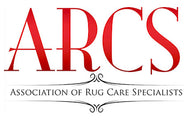Spotting Guide for Rug Owners
Spots, if treated improperly, are more likely to become permanent stains.
The best method to safely remove spots from your rug is to have it professionally cleaned by an ARCS member, who has special equipment and training in the proper method to clean your rugs. This is not always practical, this spotting guide will assist you in removing small, everyday household spills while minimizing the risk of permanent damage to your rug.
Most over-the-counter spotters are designed as a one-size-fits-all solution and are inappropriate to use on many rugs. They contain concentrations of detergents, enzymes and bleaches that can damage your rug and set what could have been a removable spot additional discoloration of your rug. Therefore, we DO NOT recommend using multi-purpose over-the-counter spotters on your rug. If you would like to purchase a spotter, please consult your local ARCS member for their recommendation. Finally, the longer a spill remains on your rug the more likely it is to stain, so the best time to attempt to remove any spills is immediately after they occur.
- Blot up spills immediately. It is important to remove as much of the excess material as quickly as possible. Using a clean, white towel press down on the stain, working from the outside of the spill to the middle. Blot, don’t rub, scrub or brush because rough treatment will damage the fibers.
- Remove any solids with a plastic spoon or credit card.
- Pre-test any spotting solution in an inconspicuous area. Test both home-made and commercial cleaning formulas on an unseen place, like the back of your rug. If dye from your rug comes off, or if the rug changes color in that area, you should NOT use this solution. WARNING:using the improper cleaning solutions can set spots and cause discoloration that may not be visible until the rug is thoroughly cleaned and rinsed.
- Don’t over-wet. Use small amounts of liquids. Over-wetting can cause the stain to spread.
- Less is More. Use cleaning solutions sparingly. Excessive use of strong chemicals can damage your rug and compound the problem.
- Use patience. Some spots respond very slowly. It’s better to take a little time when treating a spot than have to look at bad results for years.
- Rinse out any chemicals. If you used a cleaning solution, be sure to blot it up and follow up by blotting with a damp cloth. Leaving soap in your rug can cause the spot to reappear due to rapid re-soiling.
- DRY THE SPOT THOROUGHLY. Prolonged moisture can cause mildew and damage to your rug. Check back after a half day to make sure that the area is dry. If not, place a fan blowing directly on the spot until dry. If the rug has not dried in two days, consult your ARCS cleaner.
- When in doubt, contact your local ARCS member for assistance. If a spot does not respond to your treatment, contact our professionals for their expert advice.
Use each of the cleaning agents on the spot or spill in the order indicated until the spot fails to improve. Apply small amounts of the cleaning solution with a clean, white absorbent towel never use dyed towels as color could transfer. Blot frequently and continue to apply and blot until the material is no longer transferred to the towel. The final step is to blot up any remaining moisture by pressing or padding the area with an absorbent towel and weighting it down. Allow several hours to completely dry.
SPOTTING SOLUTIONS
- Apply a small amount of cold water and blot with a dry towel
- Mix 1/2 teaspoonful of hand dishwashing detergent (that does NOT contain bleaches or disinfectants) with a cup of cold water. DO NOT use laundry detergents. automatic dish washing detergents or over the counter carpet spotting products.
- Mix 1/3 cup of white distilled vinegar with 2/3 cup cold water.
- Apply a small amount of clear rubbing alcohol. Use in very small amounts to avoid damage to your rug. THIS IS NOT ADVISABLE ON LATEX BACKED OR TUFTED RUGS. Be sure of proper ventilation before using any volatile solvents, like rubbing alcohol.
- Consult your ARCS cleaner NOTE: NEVER USE BLEACH OR BLEACH CONTAINING PRODUCTS ON YOUR RUG AS IT WILL DAMAGE THE FIBERS.
Disclaimer: These are best practices, but are NOT applicable for every situation. The END USER IS SOLELY RESPONSIBLE for determining their suitability for their situation and the consequences of their use. The authors, ARCS and ARCS member firms cannot be held responsible for their application and any errors or omissions.
MATERIAL REMOVAL STEPS
- Beer 1,2,3,6
- Blood 1,2,3,5
- Butter 1,2,5
- Candle Wax 4,5
- Chewing Gum 4,2,5
- Chocolate 2,3,5
- Cocktails 1,2,3,5
- Coffee / Tea 1,2,3,5
- Cosmetics 54,2,5
- Crayons 4,2,5
- Egg 1,2,,5
- Food Coloring 5
- Fruit Juices 1,2,3,5
- Furniture Polish 2,4,3,5
- Furniture Stain 4,5,
- Glue,(Elmer’s) 2,4,5
- Glue (Carpenter’s) 2,4,5
- Glue (Contact Cement) 4,5
- Grease 2,4,3,5
- Ice Cream 1,2,3,5
- Ink 4,2,5
- Ketchup 1,2,3,5
- Milk 1,2,3,5
- Mustard 2,3,5
- Nail Polish 4,5
- Oils 2,3,4,5
- Ointments 2,3,4,5
- Paint (latex) 1,4,5
- Soft Drinks 1,2,3,5
- Tar / Asphalt 4,5
- Urine 1,2,3,5
- Vomit 1,2,3,5
- Wine 1,2,3,5




